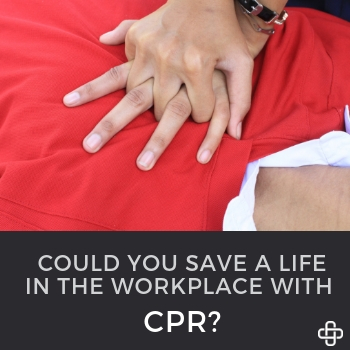 Did you know there are over 220,000 victims of sudden cardiac arrest per year in the United States with approximately 10,000 occurring in the workplace?
Did you know there are over 220,000 victims of sudden cardiac arrest per year in the United States with approximately 10,000 occurring in the workplace?
Would you be surprised to know that waiting for the arrival of emergency medical system personnel results in only 5-7% survival?
When emergency strikes in the workplace, knowing how to initiate CPR could mean saving the life of a co-worker!
Read on as we discuss what sudden cardiac arrest is, how it can happen in the workplace and steps you should take when initiating CPR.
What is Sudden Cardiac Arrest?
If you thought sudden cardiac arrest only meant having a heart attack, that’s a mistake! Sudden cardiac arrest occurs when ventricular fibrillation takes place or when the heart stops beating altogether.
Without medical attention, the victim:
- Collapses
- Stops breathing
- Doesn’t have a pulse
- Loses consciousness
- Becomes unresponsive, and;
- Dies.
Many victims have no prior history of heart disease and are stricken without warning.
How Can Your Employees Help Save a Life?
Causes of sudden cardiac arrest within the workplace may include:
- Electric Shock
- Heart Attacks
- Severe Allergic Reactions
- Drug Overdose
If you see a teen or adult who’s unconscious and not breathing normally, follow these three life-saving steps:
1. Call 911
2. Perform CPR. Quickly check the breathing. If the person isn’t breathing normally, begin CPR. Push hard and fast on the person’s chest — at the rate of 100 to 120 compressions a minute.
If you’ve been trained in CPR, check the person’s airway and deliver rescue breaths after every 30 compressions. If you haven’t been trained, just continue chest compressions.
Allow the chest to rise completely between compressions. Keep doing this until a portable defibrillator is available or emergency workers arrive.
3. Use a portable defibrillator, if one is available. It will give you step-by-step voice instructions. Continue chest compressions while the defibrillator is charging.
Deliver one shock if advised by the device and then immediately resume CPR, starting with chest compressions, or give chest compressions only, for about two minutes.
Using the defibrillator, check the person’s heart rhythm. If necessary, the defibrillator will give another shock. Repeat this cycle until the person recovers consciousness or emergency workers take over.
If untrained in CPR and will be performing Hands-Only CPR, the American Heart Association recommends the following process:
https://www.youtube.com/watch?v=O_49wMpdews
Need to Get Employees Back to Work Following Personal Medical Problems?
We do the right thing for our clients by doing the right thing for their employees. When your employees are out of work for three or more days due to a personal injury or illness, Axiom’s Occupational Health Employee Absence Management offer around the clock care to ensure a safe and quick return to work.
Our nurses act as a guide for the injured or ill employee throughout the entire recovery journey, keeping the employer updated of his/her return status. Besides evaluating an employee’s current disability and establishing appropriate treatment plans, Axiom also manages all the necessary documentation such as FMLA forms.
Give us a call at +1 (877) 502-9466 to find out how easy your return to work process can be!










